Papahānaumokuākea Marine National Monument Expansion
Papahānaumokuākea Marine National Monument will become the largest conservation area in the world following a proclamation today from President Obama expanding the marine protected area in the Northwestern Hawaiian Islands from 139,818 square miles to 582,578 square miles. The expansion will help protect the region's extensive coral reefs that are home to more than 7,000 marine species, one-quarter of which are found only in the Hawaiian Archipelago.
Permissions are granted for media use.
All media inqueries should be directed to:
Noreen_A_Nielsen@ceq.eop.gov
Claire_I_Moser@ceq.eop.gov
Ciaran.Clayton@noaa.gov

Map showing the expanded area of Papahānaumokuākea Marine National Monument. The new boundary extends out to the U.S. EEZ (shown in purple). The monument's original area is shown in blue.
Credit: NOAA
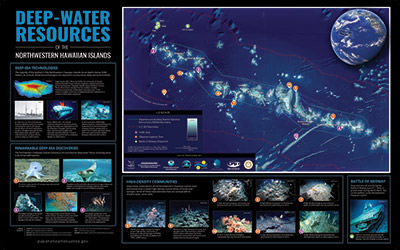
Deep-water resources of the Northwestern Hawaiian Islands, including those now protected within the expanded area of Papahānaumokuākea Marine National Monument.
Credit: NOAA
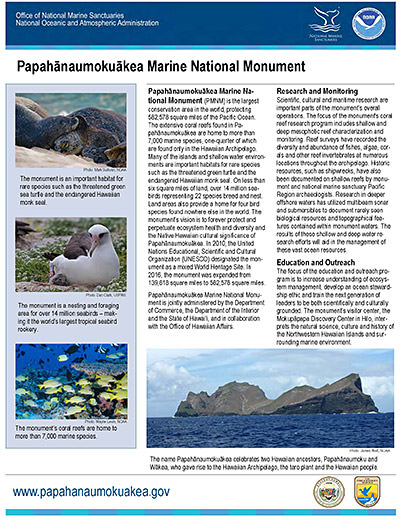
Papahānaumokuākea Marine National Monument fact sheet
Credit: NOAA
In February and March of 2016, NOAA and partners conducted an expedition to explore deep waters in and around Papahānaumokuākea Marine National Monument. Using the high-definition camera's on NOAA's Deep Discoverer remotely operated vehicle, scientists captured imagery of deep-sea biology and geology at depths ranging from 2,130 feet to 2.7 miles (650 - 4,300 meters) that had never been seen before.
On August 26, 2016, President Obama expanded the monument by 442,781 square miles, bringing the total protected area to 582,578 square miles and making it the world's largest marine protected area. Portions of the video originally filmed outside of Monument boundaries are now protected.
This expedition is part of a three-year effort to gain basic knowledge about the largely unknown marine protected areas in the Pacific. The combined information gained during this effort will help managers to better understand, and therefore protect, these special places.
Video courtesy of NOAA; produced by the Global Foundation for Ocean Exploration.
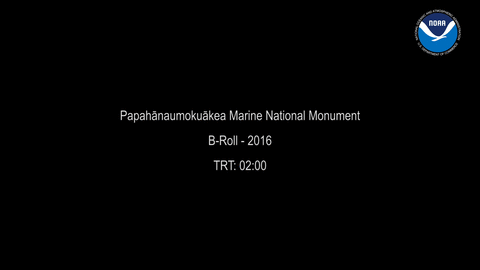
B-Roll Video
0:15 Apex predators such as ulua (giant trevally) dominate the deep reef ecosystems of the Northwestern Hawaiian Islands.
0:26 A sea cucumber, or holothurian, seen swimming just above the seafloor at a depth of ~4,085 meters on September 26, 2015.
0:33 brittle star on a species of octocoral, Liz to check
0:38 new species of octopod (“Casper”)
0:50 ctenophore (comb jelly). This red ctenophore with long tentacles was documented not far off the bottom at Southernmost Cone on September 20, 2015.
0:56 a species of octocoral
1:00 crinoid
1:06 a species of octocoral
1:09 World War I submarine S-19, which now rests on the ocean bottom at 414 meters in the middle of a sand expanse. After service in World War I, the vessel was no longer needed and was intentionally scuttled by the U.S. Navy in 1938. It now serves as a relatively new feature of hard bottom habitat (~75 years old) for deep corals to colonize. The hull, which is intact, provides a unique glimpse of a community of pioneer settlement in deep corals.
1:27 shrimp
1:33 Hawaiian monk seals on East Island, French Frigate Shoals
1:47 Dozens of green turtles basking on East Island, French Frigate Shoals
Credit: NOAA
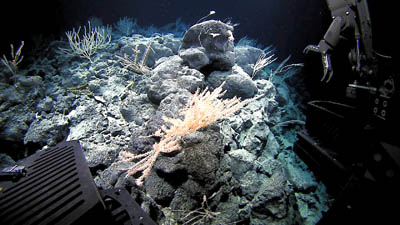
A soft coral is highlighted among a high-density biological community discovered at depths of more than 2,100 meters (6,890 ft) by a remotely operated vehicle during a 2015 NOAA Ship Okeanos Explorer mission. These corals are now protected within the expansion area of NOAA's Papahānaumokuākea Marine National Monument.
Credit: NOAA Office of Ocean Exploration and Research, 2015 Hohonu Moana: Exploring Deep Waters off Hawaiʻi
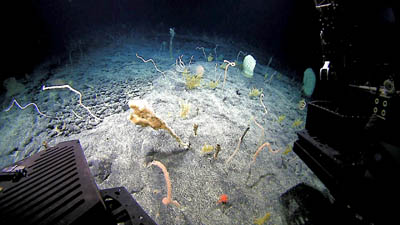
Sponges, sea-whips, and other soft corals are part of the high-density biological community discovered at 2,000 meters (6,560 ft) during a 2015 NOAA Ship Okeanos Explorer mission.
Credit: NOAA Office of Ocean Exploration and Research, 2015 Hohonu Moana: Exploring Deep Waters off Hawaiʻi
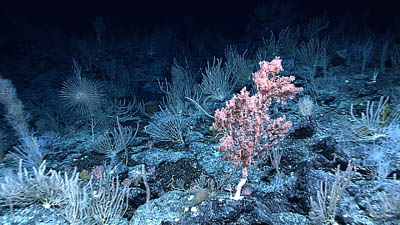
A specimen of Corallium (from the precious group of pink and red corals) stands out along a rift zone ridge, which contains the largest known high-density community of deep-sea corals and sponges in PMNM and extends over 10 miles at depths ranging from 1,800 to 2,200 meters (5,900 – 7,210 ft).
Credit: NOAA Office of Ocean Exploration and Research, 2015 Hohonu Moana: Exploring Deep Waters off Hawaiʻi
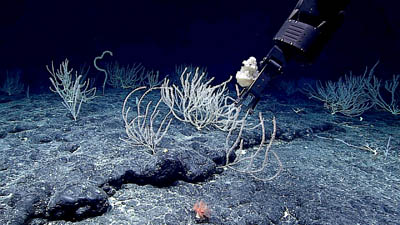
Soft corals abound in the high-density biological community discovered in 2016 at 2,000 meters (6,560 ft) - an area that is now protected within the expanded Papahānaumokuākea Marine National Monument.
Credit: NOAA Office of Ocean Exploration and Research, 2016 Hohonu Moana: Exploring Deep Waters off Hawaiʻi
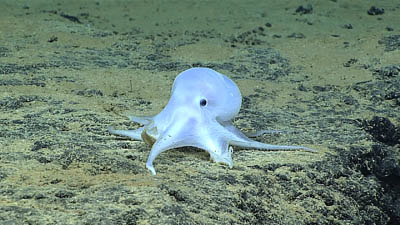
A new species of octopod discovered in 2016 at depths of more than 4,300 meters (14,100 ft) below the ocean's surface.
Credit: NOAA Office of Ocean Exploration and Research, 2016 Hohonu Moana: Exploring Deep Waters off Hawaiʻi
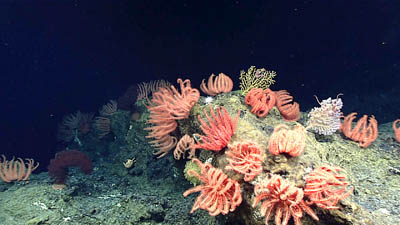
An unusually large cluster of sea stars found within a high-density biological community discovered in 2016 at a depth of 650 meters (2,130 ft), now protected within the expansion area of NOAA's Papahānaumokuākea Marine National Monument.
Credit: NOAA Office of Ocean Exploration and Research, 2016 Hohonu Moana: Exploring Deep Waters off Hawaiʻi
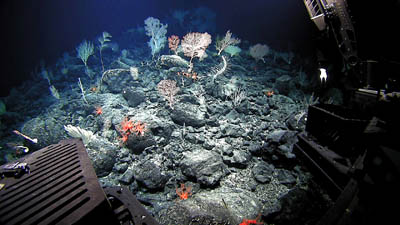
A high-density biological community discovered at 2,000 meters (6,560 ft) by a remotely operated vehicle during deep-sea explorations by the NOAA Ship Okeanos Explorer in 2015. This diverse collection of deep-sea life is now protected within the expansion area of NOAA's Papahānaumokuākea Marine National Monument.
Credit: NOAA Office of Ocean Exploration and Research, 2016 Hohonu Moana: Exploring Deep Waters off Hawaiʻi
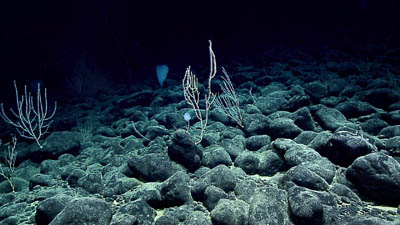
Moderate to high densities of corals and sponges were discovered on a bed of volcanic rocks at a depth of 4,000 meters (13,100 ft) in 2016, providing evidence that these important communities are found much deeper than previously thought. This location is in an area that is now protected within the expanded Papahānaumokuākea Marine National Monument.
Credit: NOAA Office of Ocean Exploration and Research, 2016 Hohonu Moana: Exploring Deep Waters off Hawaiʻi
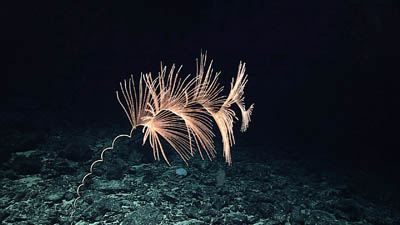
The largest known gorgonian coral in the world, this Iridogorgia bella (a type of octocoral) was discovered at 1,366 meters (4,482 ft) in 2015. At close to 6 meters in height, this coral is the size of an adult giraffe.
Credit: NOAA Office of Ocean Exploration and Research, 2015 Hohonu Moana: Exploring Deep Waters off Hawaiʻi
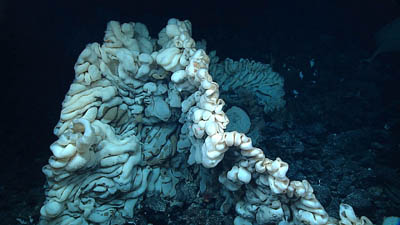
The largest known sponge in the world, discovered in 2015 at a depth of over 2,000 meters (6,560 ft). The sponge is the size of a minivan.
Credit: NOAA Office of Ocean Exploration and Research, 2015 Hohonu Moana: Exploring Deep Waters off Hawaiʻi
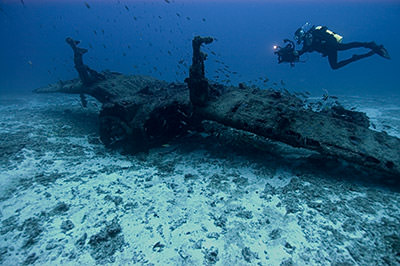
A NOAA diver documents the remains of an F4U-1 Corsair that went down off of Midway Atoll. Many regard the Vought F4U Corsair as the best single-seat fighter plane in World War II. With the recorded number of naval aircraft lost in the Hawaiian Islands reaching upwards of 1,485, many undiscovered relics of our shared maritime heritage likely remain in the depths of the Pacific Ocean now protected as part of the expanded area of Papahānaumokuākea Marine National Monument.
Credit: Tane Casserley, NOAA
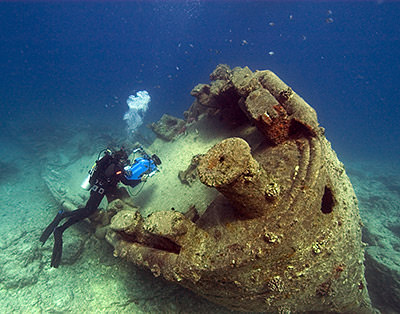
A NOAA diver inspects the remains of the USS Macaw that sank near Midway Island while attempting to rescue a submarine in 1944.
Credit: Robert Schwemmer, NOAA

